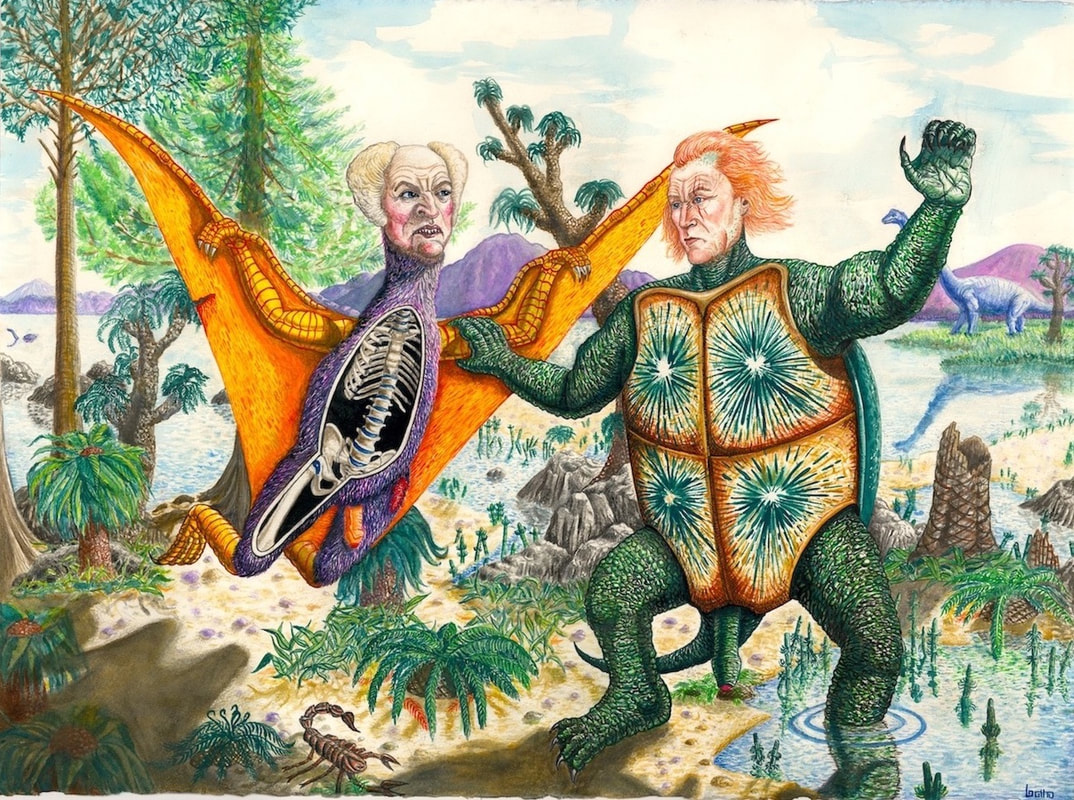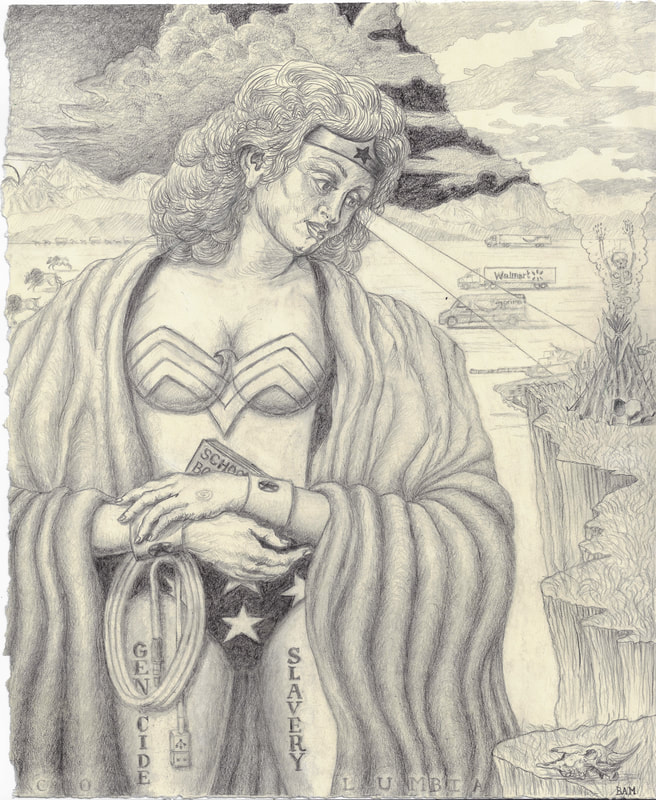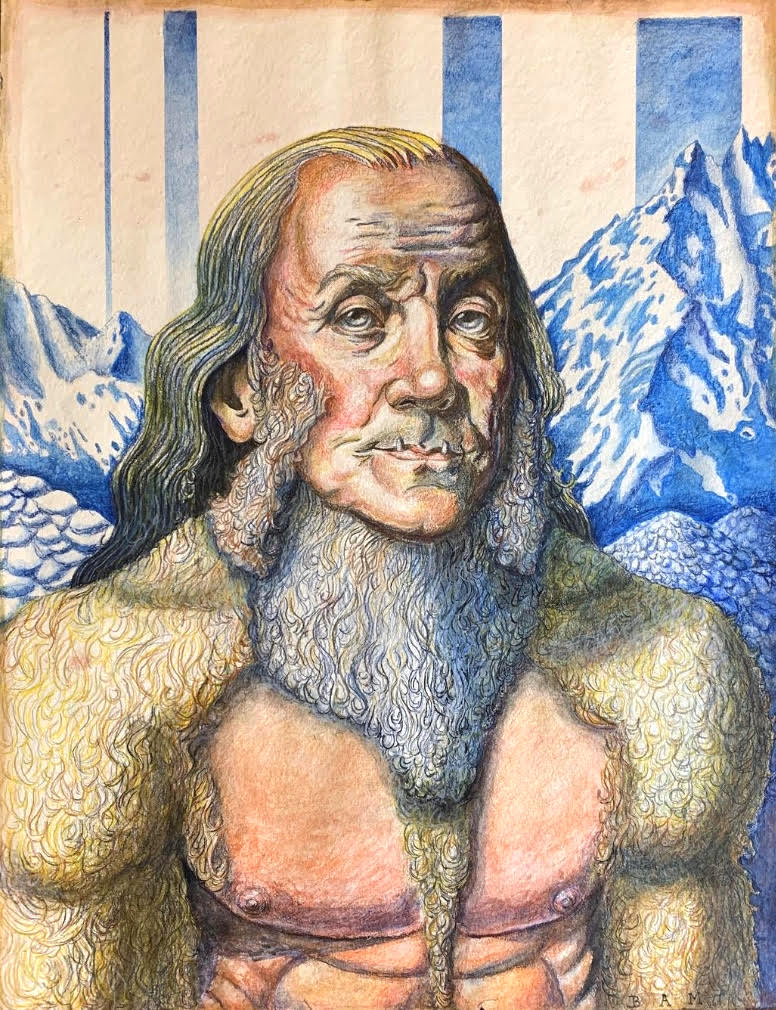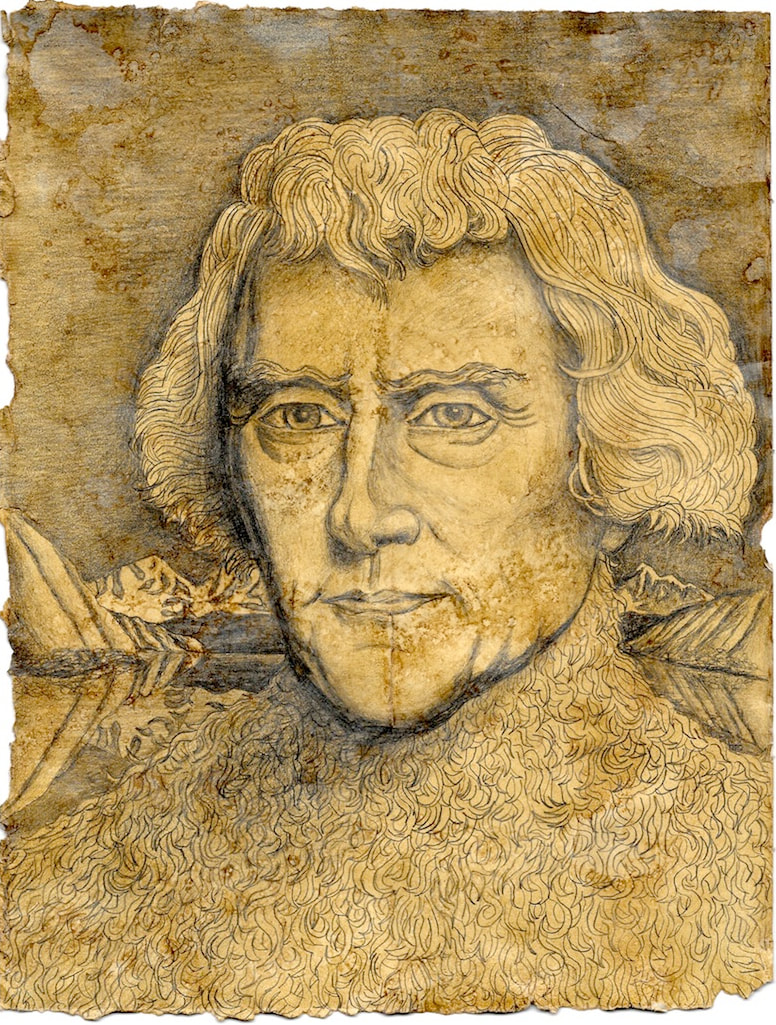Washington B.C. Audio Guide
Bryan Anthony Moore
Bryan Anthony Moore
|
1 In the Beginning, watercolor, 2020
This work was painted from a drawing I first made in 2013. The painting is an exploration of the mythic nature of history and an investigation into the way we mythologize the Founders or other public figures living in a time before the Industrial Age, molding them into demigods, giants and saints. The title is a quote from Genesis. |
|
2 Big Buck Lincoln, wood, acrylic, hardware, 2016
This work was inspired by Frida Kahlo's painting I Am a Little Deer, which was in turn, influenced by the many paintings of Saint Sebastian, who was martyred by being shot through with arrows, recalling both the grievous impalement Kahlo suffered in an accident and the bullet that pierced Lincoln’s skull. The Green Man or Cernunnos was also an influence on this piece. Cernunnos is a horned god found in Celtic mythology. He is connected with male animals, particularly the stag in rut, and this has led him to be associated with fertility and vegetation (such as trees and woods). Interestingly, not long after completing this sculpture, I learned that Carl Sandburg had claimed in Abraham Lincoln: The Prairie Years, 1926, that Abraham Lincoln once challenged an entire crowd of onlookers after dispatching a wrestling opponent, saying, “I’m the big buck of this lick. If any of you want to try it, come on and whet your horns.” Abraham Lincoln was posthumously awarded an “Outstanding American” honor in the National Wrestling Hall of Fame. The “Big Buck” Sandberg quote provided the title for my work. |
|
3&4 Confederate Charybdis and Union Scylla, watercolor, 2015
You are viewing Confederate Charybdis and Union Scylla, two watercolor paintings investigating the Civil War, and the idea that, in many ways, the conflict never ended. A kraken-like charybdis faces a hydra-like scylla across the narrow channel of Mason-Dixon. Our country must navigate these metaphorical waters in order to survive.
Atop the Charybdis of the Confederate states, a Southern Strategy elephant trunk sprouts from between contemporary GOP tusks, its nostrils leaking the poison of racism. Among the tentacles, a rattle tail and a snake head dripping xenophobic venom, evoke a rebel take on the Gadsden flag, eschewing the unity of the earlier Join or Die serpent, of Benjamin Franklin’s creation. From right top to bottom, General Stonewall Jackson, General Robert E. Lee and Jefferson Davis flesh out several tentacles. One tentacle culminates in the head of Colonel Sanders. The “Colonel” was a strictly honorary title given by his friend Governor Laffon “in recognition of his contributions to the state’s cuisine.” Sanders was not a true Southerner, hailing from Indiana originally, and was born much too late for any Civil War involvement. But his moniker always seemed to me, a Southern take on the U.S. Uncle Sam, his initials C.S. standing in for Confederate States, his adopted Southern gentleman attire, a replacement for Uncle Sam’s top-hat and tailcoat, and his snow-white goatee echoing that of Uncle Sam depictions. A spiked appendage containing an emerald colored eye (inspired by an underwater comic book creature that I recalled from childhood), completes this octo-phant (octopus-elephant hybrid). Facing down the Cephalopod of the Confederate Charybdis, a chimeric, dinosaurian creature, The Union Scylla, struts into the fray. Bedecked with the crania of Harriet S. Tubman, Frederick Douglass, Uncle Sam and another U.S, that being Ulysses S. Grant. Other heads include that of President Lincoln and a very American take on St. Nicholas, the ultimate Northerner. The Join or Die rattler also lends his tail to this unlikely amalgam. Santa and Douglass sport stylish neck fringes of black and white hair, while President Ulysses Grant sports his General stars. Ulysses is appropriately, another name for Odysseus, the hero of The Odyssey, from which the Scylla and Charybdis imagery have been derived. Frederick Douglass and Harriet Tubman occupy the lower stations of the piece, symbolizing that though the Union fought for abolition, it still had, and has, a long way to go on the path to treating minorities as equals. Thomas Nast is known as “the father of the American cartoon.” I delighted in his depictions of the Tammany Ring in my Junior High Social Studies textbook. Nast, a radical Republican, helped greatly in the elections of Lincoln and Grant, and in serving the cause of the Union during the Civil War. Nast invented the Republican Elephant. Though he didn’t create Uncle Sam or Santa, Nast was largely responsible for giving them the looks they are now known for. Before Nast these characters were drawn in many different ways. Nast sometimes depicted Santa Claus visiting the Union troops so having Santa join the heads atop this Northern beast seemed doubly appropriate. |
|
5 Ulysses Sauropod Grant, watercolor, 2021
In this work I’ve depicted Grant’s visage upon the neck of a giant sauropod dinosaur. Here is a titan from the mysterious, deep-time of our national subconscious. President Grant is lauded for his Civil War service, and for being on the right side of Reconstruction era issues and the cause of black equality (at least after the war). History is, however, quite a subjective pursuit. Little historical attention has been given to the fact that Grant secretly launched an illegal war against the Lakota and lied to Congress and the nation about it. His treachery ultimately led to Custer’s epic defeat at the Battle of Little Big Horn and to litigation that remains unsettled to this day. He is responsible for thousands of needless deaths, for the outright theft of treaty lands, and for cultural genocide. The United States Supreme Court stated, "A more ripe and rank case of dishonorable dealings will never, in all probability, be found in our history." United States v. Sioux Nation of Indians, 448 U.S. 371, 388 (1980). In this painting I’ve depicted a mythical giant from our past and then decapitated the mythical construct. |
|
6 Madison’s Constitution, graphite, 2013
James Madison was the principle author of the United States Constitution, therefore the obvious play on words and pictures in that his body’s “constitution” is revealed. Immediately after the Constitutional Convention and up until the time of his death, Madison continually edited his notes on the convention to align with his current political beliefs and to those of his allies, and to paint himself in a more favorable light for posterity. His likeness here derives from Ankylosaurus, Stegosaurus, and of course, Godzilla. The detailed watercolors are meant to harken back to scientific illustrations from the age of discovery. |
|
8 Lincoln Log, wood, turquoise, varnish, hardware, 2016
Lincoln Log’s body is from a fallen crabapple limb harvested in my backyard. The limbs were carved from fir and the head was sculpted from basswood with inlaid turquoise eyes. The swiveling neck is bamboo. The “Lincoln Log” reference is obvious. Lincoln also participated in a bit of early political theater when he was called the “rail splitter” harkening back to his early days as a farm hand and his splitting of wooden fence rails. This moniker was an attempt to connect him to his humble back-woods beginnings and the “common man” and disassociate him with an adulthood spent as a lawyer. Lincoln lived extraordinarily and it seems that everything about him was literally and figuratively larger than life — his ears were too big for his head, his tall lanky body towered over mere mortals, his top hat added still more height, his legendary 700 mile flat-boat trips to New Orleans as a youth showed a hunger for achievement, and his place in American history looms large. His grizzled look and his storied life make for quite the muse. |
|
9 Duel/Dual
Lodged in Hamilton’s Godzilla breast is one of the dueling pistols used in his fight with Aaron Burr. A musket ball entry wound in his abdomen and a wound in his liver show some of the injuries he sustained in that fatal duel. The stomach is full of gold coins in a reference to Secretary Hamilton’s support of central banking. Hamilton (a Major-General in the American Army) is shaking his rattlesnake tail defiantly in a nod to the many Revolutionary era depictions of the United States as a serpent. The Federalist Papers that Hamilton co-authored with Madison and Jay are foundational documents for the United States and are therefore contained in Representative Hamilton’s lower leg. In Hamilton’s other hollow leg, we find an ode to the Greco-Roman roots of our government. Like ancient Greece and Rome, the United States had democracy for some and slavery for others. The title, Duel, refers both to the fatal fight that ended Hamilton’s life and to the inner battles that we as human’s wage between our higher and our baser natures, the “duel” of the “dual.” Atomic breath singes Representative Hamilton’s political enemies. A human/arthropod clawed arm borrowed from Buzz-Off (a Masters of the Universe character) and Frankenstein’s monster electrodes on Hamilton’s neck, point to the chimeric, part fact, part fiction nature of these primordial Founders who stride through our national collective consciousness. |
|
10 Founding Fossils: Jefferson V. Adams, watercolor, 2017
In this work, I depict John Adams as a Pterodactyl-Man in a pitched battle against his sometime enemy, Thomas Jefferson, here portrayed as a prehistoric turtle hybrid. These adversaries would later develop a long and lasting friendship. There was a made for TV movie called The Bermuda Depths (1978) that I dimly recall watching as a young child. The film featured a haunted giant sea turtle/deity and ever since then I’ve had a soft spot for giant turtles such as the prehistoric Archelon or Stupendemys Geographicus. An amphibious prehistoric scorpion occupies the lower margin of my painting; Jefferson was a Scorpio by birth. The titan has one foot on the land and one foot in the water. Although not intentional, perhaps there’s a subconscious analogy being made to his dual nature on so many issues. Adams, ever the aristocrat, sports rouge and sharp teeth, his skeleton is exposed, and his ribs are shorn in an uncovering of various strata of myth and history. He has raked his talons across Jefferson’s face. His leg has been scraped and his wing torn in this clash of primordial American demi-gods. |
|
11 Columbia, graphite, 2021
This piece takes the painting, American Progress (John Gast, 1872) as a jumping off point. The pieces both portray the goddess Columbia, an American archetype created in the mold of other nationalist deities such as Britannia and Germania. Before the Statue of Liberty held our national consciousness as the reigning patriotic US goddess, Columbia filled this position, but thanks to Lady Liberty, Columbia has been largely forgotten. The painting American Progress is often showed in conjunction with the study of “Manifest Destiny” in history books. In American Progress the sun is rising in the “settled” and colonized East while the “Wild West” remains in darkness among stormy skies, awaiting the “illumination” that Western civilization will bring. The giant figure of Columbia strides forcefully across the plains, driving Native Americans and wild animals away in terror at her approach. In my homage I have shown the sun setting in the West. The East is now dark among cloudy, smog filled skies. Amazon and Walmart trucks have replaced the locomotives being built in the earlier painting and the wagon trains have moved from the center to the extreme West. Rather than depicting men with rifles striding through farms and Native villages occupying the background, I have depicted a desertified landscape populated only by military tanks, the remains of the once great bison herds, and the very last Native American being set ablaze by the gargantuan titan’s optic blasts in her effort to “manifest” the “settling” of the continent. In creating my own depiction of Columbia, I was struck at the similarities between her accoutrement and that of Wonder Woman, yet another patriotic demi-goddess. Both wear a single star on their forehead, the golden lasso on Wonder Woman’s hip resembles the unspooling telegraph wire being held by Columbia, and the Greco-Roman inspired elements of their respective garbs, be that the Minerva like cloth adorning Columbia or the Giant Golden Eagle on Linda Carter’s bosom that would feel at home atop a Roman Legion’s staff. I took some liberties in updating Columbia’s Western wire wear, replacing the telegraph cable with more contemporary communication connectors. I included the schoolbook from American Progress as well as Columbia’s woolen garment and elements of Wonder Woman’s attire. My Columbia has been tattooed with some of her favorite things and was partially modeled after Peter Paul Rubens drawing: Young Woman with Crossed Hands. |
|
12 Myth, ceramic, 2019
This work encompasses religion, politics and history as interrelated aspects of a national U.S. mythos. The myth of the United States somehow being a Christian nation made for and by evangelicals and other orthodox conservative Christians flies in the face of many of the writings of the most influential Founders and Framers. This teapot depicts American Mythology in general and the myth that there isn’t a separation of church and State in our legal system, in particular. It references the “tea party”, “Texas tea” (big oil) and the conservative groups peddling these claims in public school textbooks and media outlets. The base of the teapot is a Bible, the spout is a cross, and the handle a US shield. The lids are variously a Klan hood/ MAGA dunce cap and an oligarchic octopod. The text inscribed on the back of the skull reads as follows “VS” (for church vs State) followed by “Tea is for Texas, tea is for Tennessee. Tea is for the party that made a wreck of me. T is for The-Southern-strategy, Lowercase ‘t’ is a cross. T is for top tax bracket, T is for the boss, Texas Tea is for eco-genocide and irreversible loss. Lowercase ‘t’ is for trump fans burning little t’s on the lawn, tea is for the wealthy, tea party is for the pawn.” The octopus tentacles on one of the lids list the three branches of our government as well as the military, industrial, private prison and entertainment complexes. |
|
13 Emancipatosaurus: A Copper Whopper, copper, bronze, 2015
United States history often deals with times so far removed from experience that they’ve become fabled times of legend which various groups edit or mythologize at will. Characters from our Revolutionary and Civil War epochs have become giants, demi-gods and saints in a national pantheon that combines elements of religion, politics and history as interrelated aspects of a national mythos or nationalist religion. This piece depicts Abraham Lincoln as a gargantuan sauropod dinosaur, a chimeric creature built of both fact and fiction. I sculpted the piece and then had it cast in copper over bronze. The copper felt appropriate for the likeness of a president that has long been associated with the copper penny. The title is in reference to Lincoln’s “The Great Emancipator” status. “Whopper” can mean something big, it can also be used to describe a large distortion of the truth. Abraham Lincoln is revered as a national hero for his many accomplishments, including the Emancipation Proclamation and his handling of the Civil War. But not many Native People count Lincoln as a savior. The majority of his policies toward “Indians” were extremely detrimental. The Homestead Act and the Pacific Railway Act led to loss of land, lifestyle, and lifeways for many. The corruption in the Bureau of Indian Affairs was not addressed. Native Americans were forced onto reservations (the opposite of emancipation) and the brutal treatment of the removed Navajo who were forced to march the 450 miles to the Bosque Redondo, resulted in 2000 deaths. The removal of the Mescalero Apache from New Mexico was initiated, the Sand Creek massacre in Colorado resulted in hundreds of dead Cheyenne and Arapaho and though Lincoln pardoned some of the Native men that participated in the Minnesota Dakota War, the hanging of 38 was carried out, seemingly as a warning to other Natives that might consider rejecting the brutal policies of “Indian” Removal. History is subjective, not scientific. It’s what’s omitted as well as what’s included. Histories are written by the victors. |
|
14 Standard Oil Octopus, ceramic, 2020
This sculpture was made as homage to the famous Standard Oil Octopus cartoon by Joseph Keppler. This cartoon was published eight weeks before the election of 1904. It depicts "Standard Oil" as an octopus spreading across the U.S, seizing state houses and Congress in Washington, and attempting to grab the White House. The piece was meant to illustrate the control exerted by the Standard Oil monopoly and its influence over every facet of government. Well over a hundred years later Big Oil is still exerting a disproportionate influence over our government. In the age of anthropogenic climate change, this is a sobering fact. |
|
15 The Abominable Franklin, watercolor, 2021
This work is based on a graphite drawing I first conceived of in 2013. My work often combines American Founders with titanic beings from mythology or natural history, alluding to their now mythic and “giant” stature within United States histories. In this piece, that large mythic creature is the Yeti or Abominable Snowman. The Abominable Franklin just rolls off the tongue — no offense is meant. The “Abominable Snowman” name originated as a translation error when Anglo journalist Henry Newman mistranslated the Tibetan word metoh (wild) as metch (dirty or “abominable”). This painting places Franklin in the Himalaya native to the Yeti. Here, he sports fangs protruding upward from his prominent lower jaw. In Franklin’s portraits, he always seems to have a bit of an underbite, so it felt very natural for me to depict him this way. The fractured sky is probably influenced by Magritte, who often manipulated the sky in various ways in his paintings. |
|
16 The Abominable Statesman, watercolor, 2018
This watercolor depicts Thomas Jefferson as a blue-skinned yeti standing by a lake in the Himalaya. The real Jefferson had red hair, so his yeti fur is likewise an orange hue. Jefferson’s exposed musculature is beholden to the overly sculpted bodies of action figures and comic book heroes that were the first drawings and sculptures my young mind encountered. President Jefferson’s edit of the gospels from The Bible into The Life and Morals of Jesus of Nazareth or “The Jefferson Bible” as it’s colloquially known, is a great example of selectively editing. But in this case, Jefferson felt that he was removing myth from history rather than creating it, “separating the gold from the dross” as he put it. Jefferson felt that he was restoring the teachings of Christ to a pure and unadulterated form by removing miracles and supernatural occurrences from the gospels. He felt that later writers had added these things to the scriptures. Jefferson also participated in conversations about a mythical Anglo-Saxon past in which the ancestors of Englishmen and Anglo Americans, had first conceived of “common-law” in the forests of Germany, later bringing these ideas to England and her colonies. Jefferson rejected a Christian founding myth but embraced a mythical Saxon origin for his young country. |
|
18 Join or Die Quetzalcoatl, watercolor and ink, 2015
This piece was constructed using Donald Trump’s head atop a crocodilian body (after Merian), with a scorpion’s venomous tail thrown in for good measure. This creature is seen to violently assault and bloody the person of the “Join or Die” serpent. The Join or Die serpent has fused with its mystical cousin Quetzalcoatl, the mythological feathered serpent of Meso-America. The “Join or Die” serpent was first created by Benjamin Franklin as an analogy to how the disparate British American colonies must unite in order to defeat their adversaries during the “French and ‘Indian’ War,” or suffer defeat and death. This analogy used a snake because it was a common folk belief at the time, that a snake’s severed body could reanimate if the pieces were rejoined before nightfall. Later this same imagery was used by the revolutionary colonists against the British during the War of Independence. My usage of both mythical serpents was to convey the need for both Mexican and American interests to oppose the possible presidency of Donald J. Trump, which would prove harmful to both. |
|
19 Join or Die, watercolor and ink, 2015
In this painting, I updated Benjamin Franklin’s “Join or Die,” an 18th century “meme,” for the 21st century. This work refers both to the mythos of the original image and the necessity of making contemporary common cause with respect to threats of anthropogenic climate change, ocean acidification and the related mass extinctions that threaten the stability of civilization and the continuance of life as we know it on this planet. |
|
20 Giant, graphite, 2015
In this work I portray MLK Jr. as a titanic sauropod dinosaur. I used toys as models for the creatures in this drawing. I buy an animal figure souvenir whenever I go to the Field Museum in Chicago, the La Brea Tar Pits Museum, the Natural History Museum of Los Angeles County or the American Museum of Natural History in NY. One of the toys featured was a childhood toy of mine. |





















